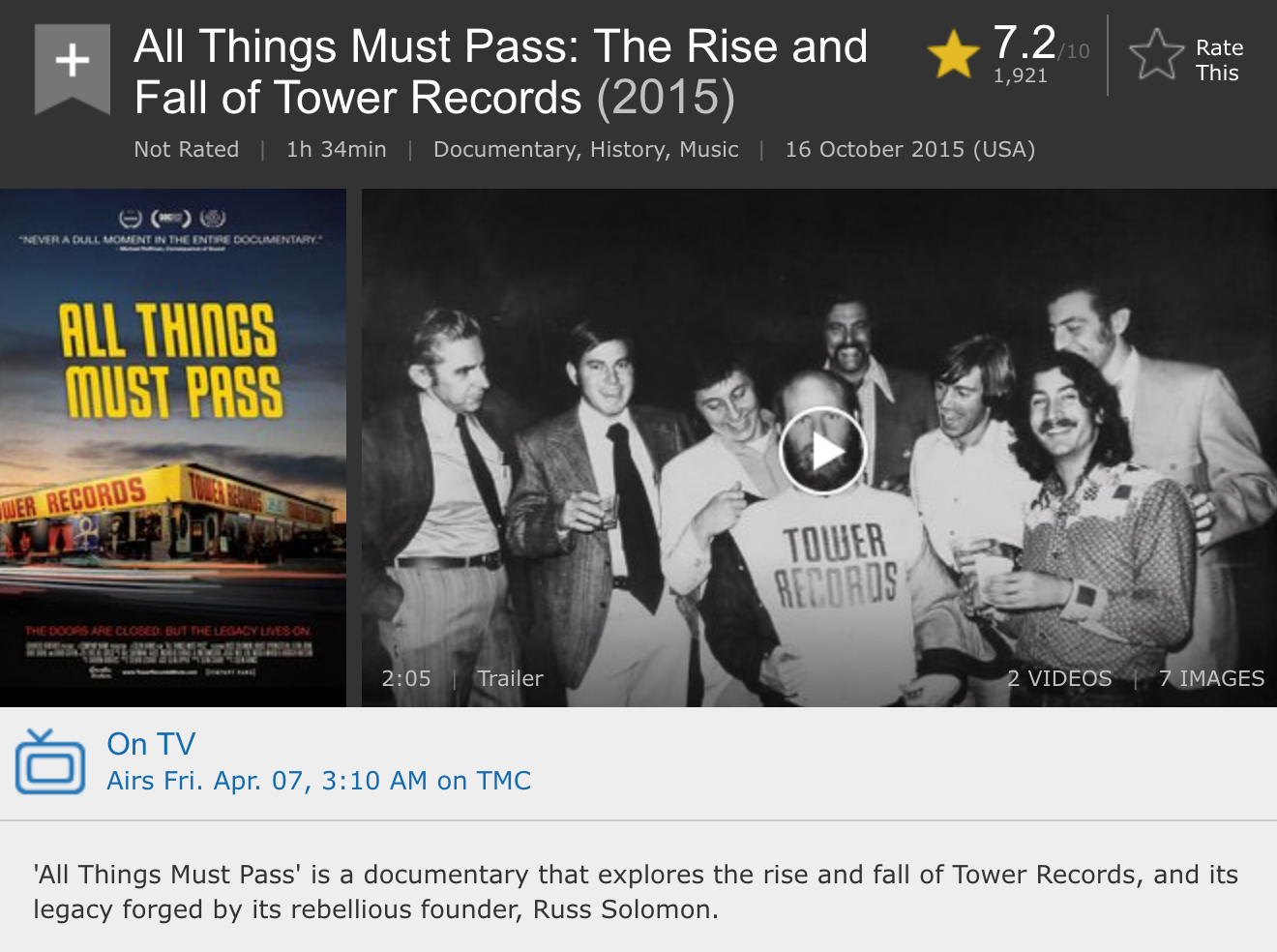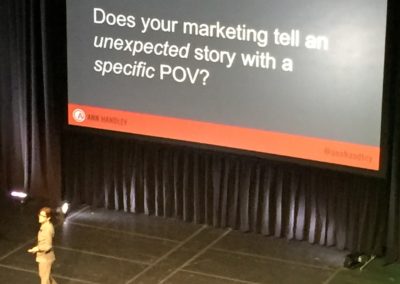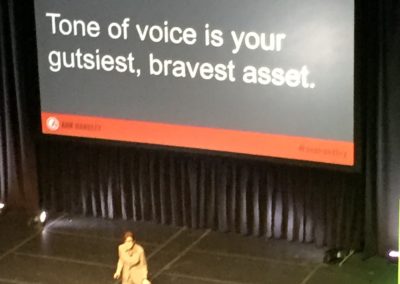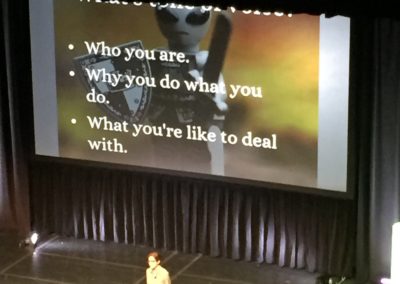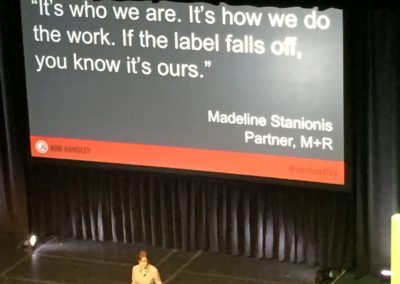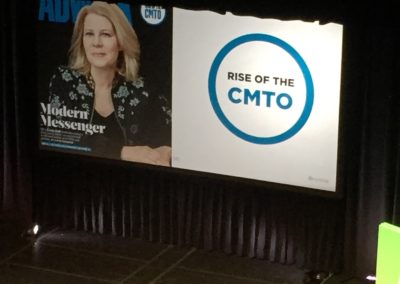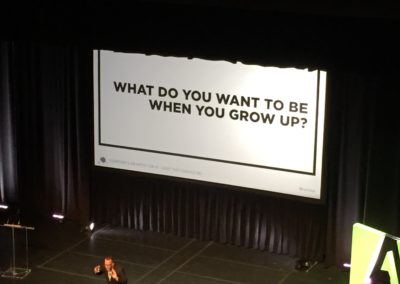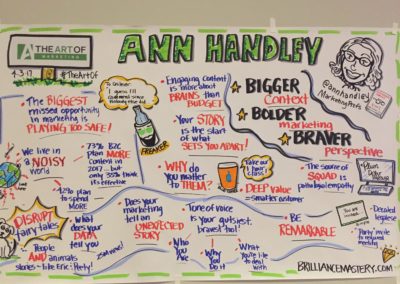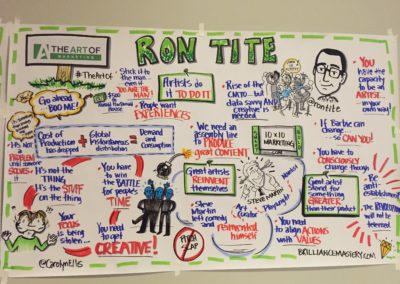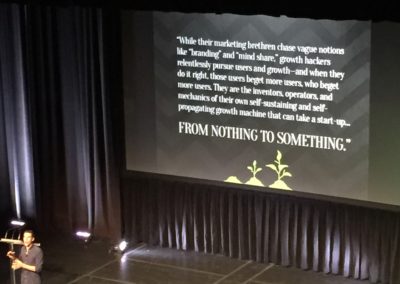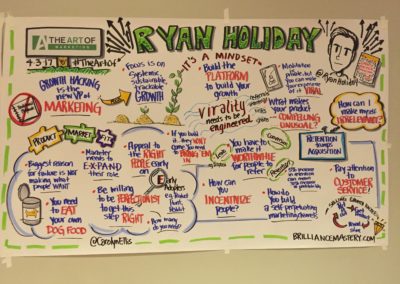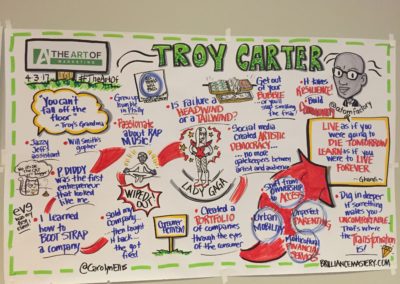Notes from The Art of Marketing conference at the Metro Toronto Convention Centre on Monday, April 3, 2017.
Content Marketing
Ann Handley is the author of Everybody Writes: Your Go To Guide to Creating Ridiculously Good Content.
During her talk, Ann Handley presented some facts about content marketing, such as “It’s no longer about why we need content. Now it is: how do we create engaging content that will grow our business?” And: “We don’t need more content. We need better content.”
As she continued giving her talk, I wondered what exactly WAS the definition of this “content marketing”?
But how do you create better content?
Think of your overall goal, and who you are trying to reach. What story are you telling, and why does it matter to them? Content should not be created as one-off articles or blog posts. Think more holistically and break the story into digestive pieces for your audience. Take what you know, innovate, and create a different story that is worth your audience’s attention. Be open-minded in your storytelling, as this may lead to stories you didn’t necessarily expect to tell, but that need to be written.
Content Marketing Strategy
There are five skills that will propel you to content marketing success:
– Social Media
– Content Curation
– Writing
– SEO
– Analytics
Ann Handley says you don’t need to master each one, but a basic understanding of them all will lead to a powerful content marketing strategies. However, content curation (I call it research) and writing are the core components.
by Andrea Sevsek, Director of NutritionPro Mentor.
Be a Better Writer
Here are some quotes to empower you to become a better writer:
“Writing is the heart of content marketing.”
“Our words are our ambassadors; your emissaries.”
“Writing is not primarily about grammar — it is important — but it is not the only thing about good writing. More importantly, writing is about clear thinking.”
Therefore, the key to becoming a better writer is to be a stronger thinker; and write with a strong and undiluted voice.
Creativity and Innovation
Ron Tite is the author of Everyone’s An Artist (Or They Should Be), and he is a former host of The Art Of conferences.
Artists do it to do it
There is a desire to consume niche content. People want to be able to geek out on the stuff they love. So being too general is not a good idea. People vote with their time and attention now, instead of their wallets.
Being creative is essential for innovation, for improvements to happen. But you need to protect the core — your bread and butter — be creative on the side. You still need to do it just to do it, because some of it might be able to be incorporated into your core materials.
Great artists reinvent themselves
Ron Tite gave the example of Steve Martin, who went from comedian to actor to playwright to musician to, most recently, art curator. Steve Martin is a perfect example who reinvented himself by drawing on his many talents and interests.
We all have the capacity to be creative in our own way.
We have to align our actions with our values — this is critically important.
We’re also in a virtual kick-back — people want the face-to-face connection, and real authentic experiences, but these have to be “out-of-the-park” experiences. Because if people make the effort to actually go somewhere for a real experience (like a concert, for example), this needs to be of the highest quality.
Great artists are anti-establishment. They are problem solvers, out-of-the-box thinkers. These are people who come up with innovative solutions to problems. Even to the kinds of problems that they might not even think of mentioning — the kind they might “put up with”
Think Dyson. Think Uber, Think AirBnB. It’s not a problem until somebody solves it.
Branding and Advertising
Terry O’Reilly is the familiar voice behind the hit CBC radio shows O’Reilly on Advertising, The Age of Persuasion, and his current program, Under the Influence, where he explores the business, the craft, and the promise of promotion. He has co-written the bestselling book, The Age of Persuasion: How Marketing Ate Our Culture, and his second book, titled This I Know: Lessons From Under The Influence will be published in the spring of 2017.
Van Halen and the Brown M&Ms
Terry started his talk by sharing a story of how Van Halen’s standard performance contract contained a provision calling for the band to be provided with a bowl of M&Ms backstage, with all the brown one having been removed. The conventional thinking would be that these were spoiled brats and just wanted to be difficult or eccentric. But no — there was another reason for this provision in the contract. The M&Ms provision was included in Van Halen’s contracts because it served a practical purpose: to provide a simple way of determining whether the technical specifications of the contract had been thoroughly read and complied with. Lead singer David Lee Roth explained in his autobiography that because their band was one of the first to take huge productions into smaller towns and cities, with nine eighteen-wheeler trucks full of gear (the standard had been three trucks maximum), their contract rider had a lot of technical requirements that were needed for all the equipment to be set up safely. So, when David Lee Roth would walk backstage, if he saw a brown M&M in that bowl… well, he would line-check the entire production. He was pretty much guaranteed to find a technical error. Because they didn’t read the contract. Sometimes it was something life-threatening that would put the whole show in jeopardy.
They just wanted to know if the producers paid attention to the details. Van Halen was just a smart band that wanted to play safely.
Great Marketing
“That’s the way we do it here” or “that’s the way it’s always been done” — these ways of thinking are kisses of death in marketing. Great marketing is about taking leaps; it’s about dreaming and NOT doing the conventional thing. There is a HUGE competitive advantage in being to turn an obstacle into an advantage. And the solution to an obstacle is always INSIDE the obstacle.
Doing Ballet in a Phone Booth
Creativity loves constraint — it forces you to be more resourceful. Practice the art of “Vuja de” — looking at something familiar like you have never seen it before. That’s what Terry means when he says that the solution is inside the obstacle. Need to think outside of your traditional category constraints. Focus on the overall goal when looking at the obstacle. Need to come at a problem in a completely different way. Re-frame it in a new angle. This strategy and counte-rintuitive thinking can be applied anywhere.
Strategy… Is Like a Chess Game
You need to out-think your competition. Strategy needs to be meaningful — and it will be if it’s born out of constraint. The biggest solutions are hiding INSIDE your obstacles. A strategy is born of hunches, because your subconscious is capable of big leaps.
Celebrate bold ideas. Dig for that insight.
Growth Hacker Marketing
Ryan Holiday is the renowned media strategist behind celebrity authors Tucker Max and Timothy Ferriss. His book Growth Hacker Marketing: A Primer on the Future of PR, Marketing, and Advertising explains the growth hacker mindset and overnight success of companies like Dropbox, Facebook, AirBnb, and Twitter.
Growth hacking is a strategy more applicable for start-ups. Anything that gets and keeps customers is marketing. But we need to consider 4 key components of start-up marketing.
- Product market fit
- Hacker growth
- Virality
- Retention and optimization
The single worst marketing decision is starting with a product nobody wants or needs.
Product Market Fit
To find out if your potential product has a market fit, start by writing a PRESS RELEASE for this product BEFORE you develop it, so you can build the needs of the end-user into it.
For research purposes, whatever your product is, there is a chance that there is a sub-Reddit for it. Reddit is a great place to look for discussions of problems that needs solving, and opinions on a certain topic.
Need to do whatever it takes to get product market fit.
What Goes Into a Press Release?
Press releases should be straightforward, written in the active voice, and should include the following key components:
A letterhead or logo — at the top of your press release — lends credibility and makes it easy to identify where the press release is coming from.
Your contact information — listed at the bottom.
Headline and subhead — The press release should have an attention-grabbing headline. This headline should summarize what your announcement is about and encourage the reader to keep reading. The sub-headline should describe the headline in more detail. Both are typically written in the subject-verb-object format and should be around 70 characters at most. For example:
Headline: County Health Department Launches Childhood Obesity Program
Subhead: Community grant keeps kids on playgrounds, off couches
Dateline — This includes the date as well as the city and province where the press release is being issued, and it precedes the first paragraph of the release.
Body — The first paragraph should succinctly summarize the entire offering, clearly articulating who, what, when, where, why, and how the offering was developed (or will be developed). Subsequent paragraphs describe those same elements in further detail. Though there are ways to frame these details to provide a certain angle to the narrative, it is important to write facts only. The body is not a place for inserting opinions on an issue — this portion should be easy for media to publish directly.
A quote — Press releases should be fact-driven, but you will often want to include some formal opinion about the issues from your business (you) or from a third party that can add credibility to your announcement (about your offering). This may be a content expert, a community leader (indicating that a problem needs a solution), or someone affected by your offering (like a testimonial). Don’t let quotes overshadow the facts — instead use them to highlight and support the narrative you’ve written.
A “boilerplate” — The boilerplate is a few sentences at the end of your press release that describes your business. This should be used consistently on press materials and written strategically, to properly reflect your business.
Hacker Growth
You want to find the right early adopters for your product, cheaply and quickly. Growth hacking is a mindset rather than a tool kit.
Virality
You want to find the right early adopters for your product, cheaply and quickly. Virality is not an accident. It’s engineered from Day 1. There is a recipe. A formula even.
Retention and Optimization
Need to guide people on how to use your product. This leads to better retention, and drives user adoption. Retention trumps acquisition. Customer service is great marketing. To optimize your offering, think of what the choke point is for your offering and how you can fix it.
Community and Social Media
Troy Carter is the Founder & CEO of Atom Factory, an entertainment company at the nexus of music, technology and media. Most recently, he joined Spotify as its global head of creator services, overseeing the company’s relationships with artists, songwriters and record companies. Carter rose to prominence as concert promoter and talent manager whose early employers included Will Smith and P. Diddy. He broke into artist management nurturing the career of hiphip sensation Eve before transforming Lady Gaga into a global pop phenomenon through the nascent innovation of social media.
Troy Carter mesmerized the audience telling us about his humble beginnings growing up in the same Philadelphia neighbourhood that Will Smith grew up in. How he had many ups and downs, but never gave up. Always kept pushing forward and trying different areas having to do with his passion — music.
He reminded us of what happened with Tower Records and Blockbuster. Two companies that refused to adapt to change and became obsolete practically overnight. There is a documentary about the demise of Tower Records, it’s called All Things Must Pass. [Note: I believe it is available on Netflix.]
So basically, Troy is instructing us to keep an eye out for changing trends and to adapt with the changing times. Then he shared with us what the current overall themes are globally:
- Urban Mobility (think transportation)
- Access (to living space, music, movies, etc. vs. ownership)
- Imperfect Parenting (as in, it’s ok not to be perfect and share stories; plus parents want to know what’s in the baby food)
- Healthy Food (people want healthy options that taste good)
- Multicultural Financial Services
Influence and Consumer Behaviour
Jonah Berger is a marketing professor at the Wharton Schoo, University of Pennsylvania, and bestselling author of Contagious: Why Things Catch On and Invisible Influence: The Hidden Forces that Shape Behaviour.
Why do some things catch on while others fail? What makes online content viral? And why do some products, ideas, and behaviours get more word of mouth than others? As part of his research, Professor Jonah Berger examines the behavioural science that underlies these questions. He examines how people make decisions, how ideas diffuse, and how social influence shapes behaviour.
Imitation
Monkey see, monkey do. One reason for this is information — we have access to similar information, which then drives our decisions that are similar. Another reason is the desire to fit in. Mimicry — when we are (most of the times unintentionally) mimicking body language — creates a sense of kinship. So it stands to reason that in order to be persuasive, one might want to be a chameleon.
Differentiation
People also have a desire to be unique. But still not too different. We care about the illusion of distinction. Like buying the same brand of care that most of your profession have, but a different colour.
It’s hard for a brand to stay hip if they go too broad, because people buy a certain brand because of what it means. Consider the following questions about brands:
- What does something signal?
- Who controls the signal?
- Shift signals to change behavious
- Sub-brranding and costly signals (in terms of time or money)
Optimal Distinctness
Professor Berger introduced the concept of being optimally distinct — still the same, but different. This is a very important concept to keep in mind when launching something new.
The difference is actually not the ideal way to success. Historically, it’s actually the second or third version of something that was “different” to come on the market that actually succeeded. Because they made improvements and/or were able to relate it to something already familiar to the intended audience.
What Drives Success?
It’s not about being different. It’s about being optimally distinct. Think of a red apple in the middle of a whole bunch of green apples. Also, the more times people are exposed to a concept or product, the higher the chance that they then accept and even like something. Exposure leads to liking. Think of your experience with a song that you didn’t really like when you first heard it. But then as you heard it more times, you grew to like it. An example for me is Rhianna’s Umbrella.
Think like Goldilocks. Your offering needs to be “just right.”
Join NutritionPro Mentor











